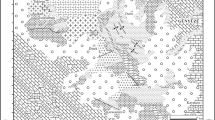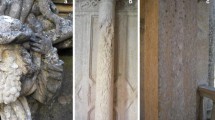Abstract
Rock sections mainly composed of quartz (coming from orthoquartzite, quartz metagreywacke, pegmatite quartz, vein quartz, chert, and flint) were subjected to experimental etching in 1 M NaOH solution at 80 °C. After 4 h–14 days, the rock sections were analysed using a scanning electron microscopy (SEM) combined with energy-dispersive spectrometer. Representative areas were documented in backscattering mode and analysed using fully automatic petrographic image analysis (PIA). Specific features connected to alkaline etching were observed on the surface of the rock sections: dissolution gaps, accentuation of pre-existing microcracks, etched out parts of aggregates, and the formation of altered silica-rich layer, and alkali–silica gels, all influencing the greyscale spectrum of the BSE microphotographs. Using SEM-PIA, it was possible to quantify the area affected by alkaline etching (etched area) and to express it as a percentage of the total area analysed. A very good correlation was found between the etched area and alkali–silica reaction potential of investigated rocks measured according to an accelerated mortar bar test.








Similar content being viewed by others
References
Andrade T, Silva JJR, da Silva CM, Hasparyk NP (2008) History of some AAR cases in the Recife region of Brazil. In: Broekmans MATM, Wigum BJ (eds) Proceedings of the 13th international conference on alkali–aggregate reaction. Trondheim, Norway, pp 730–743
ASTM C1260-07 (2007) Standard test method for potential alkali reactivity of aggregates (mortar-bar Method). ASTM International, West Conshohocken
ASTM C289 (2007) Standard test method for potential alkali–silica reactivity of aggregates (chemical method). ASTM International, West Conshohocken
Bažant ZP, Steffens A (2000) Mathematical model for kinetics of alkali–silica reaction in concrete. Cement Concrete Res 30(3):419–428
Bektas F, Topal T, Goncuoglu MC, Turanli L (2008) Evaluation of the alkali reactivity of cherts from Turkey. Constr Build Mater 22(6):1183–1190
Broekmans MATM, Jansen JBH (1998) Silica dissolution in impure sandstone: application to concrete. J Geochem Explor 62(1–3):311–318
Bulteel D, Rafaï N, Degrugilliers P, Garcia-Diaz E (2004) Petrography study on altered flint aggregate by alkali–silica reaction. Mater Charact 53(2–4):141–154
Chace FM (1956) Abbreviations in field and mine geological mapping. Econ Geol 51:712–723
Chappex T, Scrivener KL (2012) The influence of aluminium on the dissolution of amorphous silica and its relation to alkali silica reaction. Cement Concrete Res 42(12):1645–1649
ČSN 72 1179 (1968) Determination of reactivity of aggregates in connection with alkalis (in Czech). Czech Normalization Institute, Prague
Dove PM (1995) Kinetic and thermodynamic controls on silica reactivity in weathering environments. In: White AF, Brantley SL (eds) Chemical weathering rates of silicate minerals, vol 31. Mineralogical Society of America, Short Course, pp 236–290
Dreyer W (1973) The science of rock mechanics. Part I. The strength properties of rocks, second ed. Series on rock and soil mechanics. Trans Tech Pub, Clausthal, Germany
Dunant CF, Scrivener KL (2012) Effects of aggregate size on alkali–silica-reaction induced expansion. Cement Concrete Res 42(6):745–751
Fernandes I (2009) Composition of alkali–silica reaction products at different locations within concrete structures. Mater Charact 60(7):655–668
Fernandes I (2015) Role of granitic aggregates in the deterioration of a concrete dam. B Eng Geol Environ 74(1):195–206
Fernandes I, Broekmans MATM (2013) Alkali–silica reactions: an overview. Part I. Metallogr Microstruct Anal 2(4):257–267
García del Amo D, Calvo Pérez B (2001) Diagnosis of the alkali–silica reactivity potential by means of digital image analysis of aggregate thin sections. Cement Concrete Res 31(10):1449–1454
Gillespie MR, Styles MT (1999) BGS rock classification scheme. Volume 1. Classification of igneous rocks. British Geological Survey, Report No. RR 99-06, Nottingham, UK
Jensen V (2012) The controversy of alkali carbonate reaction: state of art on the reaction mechanisms and behaviour in concrete. In: Drimalas T, Ideker JH, Fournier B (Eds.) Proceedings of the 14th international conference on alkali-aggregate reaction, Austin, USA, p 10
Khouchaf L, Boinski F, Tuilier MH, Flank AM (2006) Characterization of heterogeneous SiO2 materials by scanning electron microscope and micro fluorescence XAS techniques. Nucl Instrum Meth B 252(2):333–338
Kretz R (1983) Symbols for rock-forming minerals. Am Miner 68(1–2):277–279
Kuchařová A, Götze J, Šachlová Š, Pertold Z, Přikryl R (2016) Microscopic and CL spectroscopic characterization of quartz exhibiting different ASR potential. Microsc Microanal. doi:10.1017/S1431927615015524
Leemann A, Holzer L (2005) Alkali-aggregate reaction—identifying reactive silicates in complex aggregates by ESEM observation of dissolution features. Cement Concrete Comp 27(7–8):796–801
Lindgård J, Nixon PJ, Borchers I, Schouenborg B, Wigum BJ, Haugen M, Åkesson U (2010) The EU “PARTNER” Project—European standard tests to prevent alkali reactions in aggregates: final results and recommendations. Cement Concrete Res 40(4):611–635
Lu D, Fournier B, Grattan-Bellew PE (2006) Evaluation of accelerated test methods for determining alkali–silica reactivity of concrete aggregates. Cement Concrete Comp 28(6):546–554
Lukschová Š, Přikryl R, Pertold Z (2009) Petrographic identification of alkali–silica reactive aggregates in concrete from 20th century bridges. Constr Build Mater 23(2):734–741
Oxford Instruments (2015) http://www.oxford-instruments.com. Accessed 16 Oct 2015
Passchier CW, Trouw RAJ (2005) Microtectonics, 2nd edn. Springer, Berlin
Petruk W (1986) Image analysis: an overview of developments. CANMET Report 86-4E, pp 1–5
Pettijohn FJ, Potter PE, Siever R (1972) Sand and sandstone. Springer, Berlin
Ponce JM, Batic OR (2006) Different manifestations of the alkali–silica reaction in concrete according to the reaction kinetics of the reactive aggregate. Cement Concrete Res 36(6):1148–1156
Přikryl R (2006) Assessment of rock geomechanical quality by quantitative rock fabric coefficients: limitations and possible source of misinterpretations. Eng Geol 87(3–4):149–162
Rajabipour F, Giannini E, Dunant C, Ideker JH, Thomas MDA (2015) Alkali–silica reaction: current understanding of the reaction mechanisms and the knowledge gaps. Cement Concrete Res 76:130–146
Ramos VIM (2013) Characterization of the potential reactivity to alkalis of Portuguese aggregates for concrete. PhD Thesis, University of Porto, Porto, p 417
Robertson S (1999) BGS rock classification scheme. Volume 2. Classification of metamorphic rocks. British Geological Survey, Report No.: RR 99-02, Nottingham, UK
Šachlová Š (2013) Microstructure parameters affecting alkali–silica reactivity of aggregates. Constr Build Mater 49:604–610
Šachlová Š, Přikryl R, Pertold Z (2010) Alkali–silica reaction products: comparison between samples from concrete structures and laboratory test specimens. Mater Charact 61(12):1379–1393
Šachlová Š, Burdová A, Pertold Z, Přikryl R (2011) Macro- and micro-indicators of ASR in concrete pavement. Mag Concrete Res 63(8):553–571
Šachlová Š, Kuchařová A, Pertold Z, Přikryl R, Fridrichová M (2015) Quantitative assessment of alkali silica reaction potential of quartz-rich aggregates: comparison of chemical test and accelerated mortar bar test improved by SEM-PIA. B Eng Geol Environ. doi:10.1007/s10064-015-0812-z
SPSS Software (2015) SigmaScan®Pro 5.0.0. http://www.sigmaplot.com/index.php. Accessed 22 Jul 2015
St John DA, Poole AB, Sims I (1998) Concrete petrography. A handbook of investigative techniques, Arnold
Šťastná A, Nekvasilová Z, Přikryl R, Šachlová Š (2013) Microscopic examination of alkali-reactive volcanic rocks from the Bohemian Massif (Czech Republic). The 3rd international conference on sustainable construction materials and technologies, Kyoto, Japan, p 10
SPI Supplies (2015). http://www.2spi.com. Accessed 10 Sept 2015
Tescan (2015). http://www.tescan.com. Accessed 10 Sept 2015
TP 137 (2015) Elimination of alkaline reaction of aggregates in concrete structures (in Czech). Road and Motorway Directorate of the Czech Republic, Prague, p 29
Wigum BJ, French WJ, Howarth RJ, Hills C (1997) Accelerated tests for assessing the potential exhibited by concrete aggregates for alkali-aggregate reaction. Cement Concrete Comp 19(5–6):451–476
Acknowledgments
This study was financially supported from Research Project P104/12/0915 provided by the Czech Science Foundation. Financing is also acknowledged from the OPPK Project CZ.2.16/3.1.00/21516. Special thanks belong to Professor Karel Miskovsky from Envix Nord AB for his assistance with the selection of Swedish samples and to M. Fridrichová for her assistance with the SEM imaging.
Author information
Authors and Affiliations
Corresponding author
Additional information
This article is part of a Topical Collection in Environmental Earth Sciences on “Geomaterials used as construction raw materials and their environmental interactions” guest edited by Richard Přikryl, Ákos Török, Magdalini Theodoridou, and Miguel Gomez-Heras.
Rights and permissions
About this article
Cite this article
Šachlová, Š., Kuchařová, A., Pertold, Z. et al. Evaluation of alkali–silica reaction potential of quartz-rich rocks by alkaline etching of polished rock sections. Environ Earth Sci 75, 730 (2016). https://doi.org/10.1007/s12665-016-5519-3
Received:
Accepted:
Published:
DOI: https://doi.org/10.1007/s12665-016-5519-3




